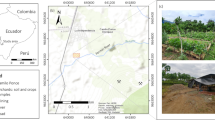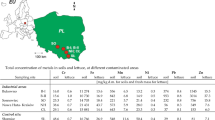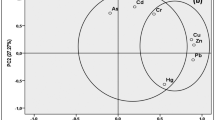Abstract
Background, Aim and Scope
In the former mining area of Northern France, the number of diseases (cancers, malformations, backwardness...) is about ten times above the national average. Environmental surveys conducted by the Ministry of Health have showed that more than 10% of children living around a lead smelter located in this area had lead levels higher than 100 µg L-1 of blood (25% in the closest city). Two main factors contribute to the population exposure: the ingestion of plants produced in the contaminated area, and also the ingestion or the inhalation of contaminated dust or soil. It is usually known that these particles are key routes of exposure to lead for younger children, in particular via hand-to-mouth transfer. For a better understanding of this problem, researchers investigated different exposure sources like soil and vegetable contamination. Materials and Methods: All these parameters that contribute to the assessment of environmental and health risks of metal contamination have been measured. About 170 composite samples of soils around the smelter or from reference areas have been analysed, mainly from fields (70), kitchen gardens (60) and lawns (38). Total contents of Cd and Pd were measured in the organo-mineral layer (0-25cm) of soils. Composite grass samples were also taken on the lawns. Crops and vegetables were sampled from fields and kitchen gardens and then, parts of the plant intended only for consumption were washed and analysed. Results: For the organo-mineral horizon of the studied sites and located in various environmental contexts (contaminated or reference), we found a very broad range of metal concentrations. Generally, the data showed a strong variability of the physicochemical parameters of the urban soils (kitchen gardens, lawns), in particular with regard to lead. This work showed that cultivated plants (agricultural or kitchen garden) or lawn grass are also significantly contaminated by heavy metals, especially lawn grasses, cereal grains (wheat, barley) and lettuces sampled around the smelter. Moreover, the proportion of lead present on lawn grasses could reach 50% of the total contamination of the plants because of the deposition of contaminated dust. Discussion: The values of pollution in agricultural field and kitchen garden soils located near the smelter were respectively about 20 and 30 times above the agricultural regional reference values, probably due to the atmospheric emissions from a smelter that significantly increases the concentrations of metals in the upper horizons of the neighbouring soils. This pollution results in a high level of contamination of plants grown of these soils. Conclusions: The results showed that heavy metals in soils, particles (dust and soil) or plants of kitchen gardens, lawns or playgrounds could be potentially transferable to the users, and in particular to young children, and could then contribute, to a considerable share, to the exposure of the population living in a contaminated area around a smelter brought about through inhalation, direct ingestion of particles or consumption of plants. Recommendations and Perspectives: These results highlight that the consumption of home-grown vegetables can constitute a risk of exposure, in particular for cadmium, and especially in children. This work also underlined the role of the contaminated soil particles in the Pb contamination of the human food chains and their environment. Because of the complexity of the various methods of population exposure, it will be necessary to complete the data base, in partucular in urban areas. The main objective of this future work will be to relate the degree of environmental contamination with the lead level in child bood, and to integrate other environmental compartments like outdoor and indoor dust of the dwellings into the model of pathway exposure.
Similar content being viewed by others
Author information
Authors and Affiliations
Corresponding author
Rights and permissions
About this article
Cite this article
Pruvot, C., Douay, F., Hervé, F. et al. Heavy Metals in Soil, Crops and Grass as a Source of Human Exposure in the Former Mining Areas (6 pp). J Soils Sediments 6, 215–220 (2006). https://doi.org/10.1065/jss2006.10.186
Received:
Accepted:
Published:
Issue Date:
DOI: https://doi.org/10.1065/jss2006.10.186




